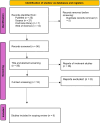Multimodal diagnostic tools and advanced data models for detection of prodromal Parkinson's disease: a scoping review
- PMID: 40155878
- PMCID: PMC11951780
- DOI: 10.1186/s12880-025-01620-5
Multimodal diagnostic tools and advanced data models for detection of prodromal Parkinson's disease: a scoping review
Abstract
Background: Parkinson's Disease (PD) is a progressive neurodegenerative disorder characterized by the loss of dopaminergic neurons in the substantia nigra pars compacta. PD is diagnosed by a combination of motor symptoms including bradykinesia, resting tremors, rigidity and postural instability. Prodromal PD is the stage preceding the onset of classic motor symptoms of PD. The diagnosis of prodromal PD remains challenging despite many available diagnostic modalities.
Aim: This scoping review aims to investigate and explore the current diagnostic modalities used to detect prodromal PD, focusing particularly on multimodal imaging analysis and AI-based approaches.
Methods: We adhered to the PRISMA-SR guidelines for scoping reviews. We conducted a comprehensive literature search at multiple databases such as PubMed, Scopus, Web of Science, and the Cochrane Library from inception to July 2024, using keywords related to prodromal PD and diagnostic modalities. We included studies based on predefined inclusion and exclusion criteria and performed data extraction using a standardized form.
Results: The search included 9 studies involving 567 patients with prodromal PD and 35,643 control. Studies utilized various diagnostic approaches including neuroimaging techniques and AI-driven models. sensitivity ranging from 43 to 84% and specificity up to 96%. Neuroimaging and AI technologies showed promising results in identifying early pathological changes and predicting PD onset. The highest specificity was achieved by neuromelanin-sensitive imaging model, while highest sensitivity was achieved by standard 10-s electrocardiogram (ECG) + Machine learning model.
Conclusion: Advanced diagnostic modalities such as AI-driven models and multimodal neuroimaging revealed promising results in early detection of prodromal PD. However, their clinical application as screening tool for prodromal PD is limited because of the lack of validation. Future research should be directed towards using Multimodal imaging in diagnosing and screening for prodromal PD.
Clinical trial number: Not applicable.
Keywords: AI; ECG; MRI; Multimodal diagnostic imaging; Prodromal PD; Scoping review.
© 2025. The Author(s).
Conflict of interest statement
Declarations. Ethics approval: Not applicable. Consent for publication: Not applicable. Competing interests: The authors declare no competing interests.
References
-
- Kouli A, Torsney KM, Kuan W-L. Parkinson’s disease: etiology, neuropathology, and pathogenesis. In: Stoker TB, Greenland JC, editors. Parkinson’s disease: pathogenesis and clinical aspects. Brisbane (AU): Codon. 2018. - PubMed
-
- Ross GW, Abbott RD, Petrovitch H, Tanner CM, White LR. Pre-motor features of Parkinson’s disease: the Honolulu-Asia aging study experience. Parkinsonism Relat Disord. 2012;18(Suppl 1):S199–202. - PubMed
-
- Goldman SM. Environmental toxins and Parkinson’s disease. Annu Rev Pharmacol Toxicol. 2014;54:141–64. - PubMed
Publication types
MeSH terms
LinkOut - more resources
Full Text Sources
Medical
Research Materials
Miscellaneous


